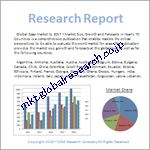目次
第1章.軍事用センサーの世界市場エグゼクティブサマリー
1.1.軍用センサーの世界市場規模・予測(2022-2032年)
1.2.地域別概要
1.3.セグメント別概要
1.3.1.プラットフォーム別
1.3.2.アプリケーション別
1.3.3.タイプ別
1.4.主要トレンド
1.5.景気後退の影響
1.6.アナリストの提言と結論
第2章.軍事用センサーの世界市場の定義と調査前提
2.1.調査目的
2.2.市場の定義
2.3.調査の前提
2.3.1.包含と除外
2.3.2.限界
2.3.3.供給サイドの分析
2.3.3.1.入手可能性
2.3.3.2.インフラ
2.3.3.3.規制環境
2.3.3.4.市場競争
2.3.3.5.経済性(消費者の視点)
2.3.4.需要サイド分析
2.3.4.1.規制の枠組み
2.3.4.2.技術の進歩
2.3.4.3.環境への配慮
2.3.4.4.消費者の意識と受容
2.4.推定方法
2.5.調査対象年
2.6.通貨換算レート
第3章.軍事用センサーの世界市場ダイナミクス
3.1.市場促進要因
3.1.1.監視と状況認識の強化
3.1.2.国防予算と近代化プログラムの増加
3.1.3.センサー統合の技術的進歩
3.2.市場の課題
3.2.1.高い統合コストと相互運用性の問題
3.2.2.サイバーセキュリティの脅威とデータの脆弱性
3.3.市場機会
3.3.1.マルチセンサー融合技術
3.3.2.自律・無人システムの拡大
3.3.3.研究開発投資の拡大
第4章.軍事用センサーの世界市場産業分析
4.1.ポーターの5フォースモデル
4.1.1.サプライヤーの交渉力
4.1.2.買い手の交渉力
4.1.3.新規参入者の脅威
4.1.4.代替品の脅威
4.1.5.競合他社との競争
4.1.6.ポーターの5フォースモデルへの未来的アプローチ
4.1.7.ポーター5フォースのインパクト分析
4.2.PESTEL分析
4.2.1.政治的
4.2.2.経済的
4.2.3.社会的
4.2.4.技術的
4.2.5.環境
4.2.6.法律
4.3.トップの投資機会
4.4.トップ勝ち組戦略
4.5.破壊的トレンド
4.6.業界専門家の視点
4.7.アナリストの推奨と結論
第5章 軍用センサーの世界市場軍用センサーの世界市場規模・予測:プラットフォーム別 2022-2032
5.1.セグメントダッシュボード
5.2.軍用センサーの世界市場プラットフォーム別売上動向分析、2022年・2032年 (百万米ドル/億ドル)
5.2.1.エアボーン
5.2.2.陸上
5.2.3.海軍
5.2.4.軍需品
5.2.5.人工衛星
第6章.軍事用センサーの世界市場規模・用途別予測 2022-2032
6.1.セグメントダッシュボード
6.2.軍用センサーの世界市場アプリケーション別売上動向分析、2022年・2032年 (百万米ドル/億ドル)
6.2.1.情報・監視・偵察(ISR)
6.2.2.電子戦
6.2.3.目標認識
6.2.4.航法と誘導
6.2.5.その他
第7章.軍用センサーの世界市場規模・タイプ別予測 2022-2032
7.1.セグメントダッシュボード
7.2.軍用センサーの世界市場タイプ別売上動向分析、2022年・2032年 (百万米ドル/億ドル)
7.2.1.レーダーセンサー
7.2.2.赤外線センサー
7.2.3.音響センサー
7.2.4.磁気センサー
7.2.5.圧力センサー
7.2.6.その他
第8章.軍用センサーの世界市場規模・地域別予測 2022-2032
8.1.北米軍用センサー市場
8.1.1.米国軍用センサー市場
8.1.1.1.プラットフォームの内訳規模と予測、2022~2032年
8.1.1.2.用途別市場規模予測、2022年~2032年
8.1.2.カナダの軍事用センサー市場
8.2.欧州軍用センサー市場
8.2.1.イギリス軍用センサー市場
8.2.2.ドイツのミリタリーセンサー市場
8.2.3.フランス軍用センサー市場
8.2.4.スペインのミリタリーセンサー市場
8.2.5.イタリアのミリタリーセンサー市場
8.2.6.その他のヨーロッパ軍用センサー市場
8.3.アジア太平洋軍用センサー市場
8.3.1.中国軍用センサー市場
8.3.2.インドのミリタリーセンサー市場
8.3.3.日本のミリタリーセンサー市場
8.3.4.オーストラリア軍用センサー市場
8.3.5.韓国の軍事用センサー市場
8.3.6.その他のアジア太平洋地域軍用センサー市場
8.4.中南米の軍事用センサー市場
8.4.1.ブラジルの軍用センサー市場
8.4.2.メキシコ軍用センサー市場
8.4.3.その他のラテンアメリカ軍用センサー市場
8.5.中東・アフリカの軍事用センサー市場
8.5.1.サウジアラビアの軍事用センサー市場
8.5.2.南アフリカの軍事用センサー市場
8.5.3.その他の中東・アフリカ軍用センサー市場
第9章.競合他社の動向
9.1.主要企業のSWOT分析
9.1.1.トップ企業1
9.1.2.トップ企業2
9.1.3.トップ企業3
9.2.トップ市場戦略
9.3.企業プロフィール
9.3.1.第一企業のプロフィール
9.3.1.1.主要情報
9.3.1.2.概要
9.3.1.3.財務(データの入手可能性による)
9.3.1.4.製品概要
9.3.1.5.市場戦略
9.3.2.第二の会社概要
9.3.3.第三の会社概要
9.3.4.第4の会社概要
9.3.5.第5回会社概要
9.3.6.第6回会社概要
9.3.7.第7回会社概要
9.3.8.第8回会社概要
9.3.9.第9回会社概要
9.3.10.第10回会社概要
9.3.11.第11回 会社概要
9.3.12.第12回 会社概要
9.3.13.第13回 会社概要
9.3.14.第14回会社概要
9.3.15.第15回会社概要
第10章.研究プロセス
10.1.調査プロセス
10.1.1.データマイニング
10.1.2.分析
10.1.3.市場推定
10.1.4.バリデーション
10.1.5.出版
10.2.研究属性
表一覧
表1.軍用センサーの世界市場、レポートスコープ
表2.軍用センサーの世界市場 2022-2032年地域別推定・予測 (百万米ドル/億ドル)
表3.軍事用センサの世界市場:プラットフォーム別2022年~2032年予測・予測(百万ドル/億ドル)
表4.軍事用センサーの世界市場 2022-2032年用途別見積もりと予測 (百万米ドル/億ドル)
表5.軍用センサーの世界市場タイプ別見積もりと予測 2022-2032 (百万米ドル/億ドル)
表6.軍用センサーの世界市場:セグメント別推計・予測 2022-2032 (百万米ドル/億米ドル)
表7.北米の軍用センサー市場:2022年~2032年の推定と予測(USD Million/Billion)
表8.欧州軍用センサー市場予測:2022-2032年(百万米ドル/億ドル)
表 9.アジア太平洋軍用センサー市場の見積もりと予測、2022年~2032年 (百万米ドル/億ドル)
表10.中南米軍用センサー市場予測:2022-2032年 (百万米ドル/億ドル)
表 11.中東・アフリカ軍用センサー市場の見積もりと予測、2022年~2032年 (百万米ドル/億ドル)
図表一覧
図1.軍用センサーの世界市場、調査手法
図2.軍用センサーの世界市場:市場推定手法
図3.軍用センサーの世界市場:主要動向2023年
図4.軍用センサーの世界市場:2022年~2032年の成長見通し
図5.軍用センサーの世界市場、ポーターの5フォースモデル
図6 軍用センサーの世界市場:PESTEL分析
図7.軍用センサーの世界市場:バリューチェーン分析
図8.軍用センサーの世界市場:セグメント別、2022年・2032年(百万ドル/億ドル)
図9. 軍用センサーの北米市場、2022年~2032年(百万ドル/億ドル)
図 10.軍用センサーのヨーロッパ市場 2022年~2032年 (百万米ドル/億米ドル)
図 11.アジア太平洋地域の軍用センサー市場 2022年~2032年 (百万米ドル/億米ドル)
図 12.中南米の軍事用センサー市場 2022 & 2032 (百万米ドル/億ドル)
図 13.中東・アフリカ軍用センサー市場 2022~2032 (百万米ドル/億米ドル)
図 14.軍用センサーの世界市場、企業市場シェア分析(2023年)
One of the primary drivers fueling the growth of the military sensors market is the surging demand for enhanced battlefield awareness and surveillance capabilities. Military forces across the globe are prioritizing next-generation sensor technologies to strengthen reconnaissance, electronic warfare, and combat efficiency. Governments and defense organizations are heavily investing in sensor-laden unmanned systems, leveraging artificial intelligence (AI) and autonomous sensor networks to enhance national security. Additionally, increased military budgets, particularly in the U.S., China, India, and European nations, are expediting the adoption of cutting-edge sensor solutions across different defense platforms.
The rising incorporation of multi-sensor fusion technologies is further driving market growth. These systems integrate radar, infrared, acoustic, and seismic sensors to provide real-time, multi-dimensional situational awareness, improving target acquisition and threat mitigation. Moreover, advancements in miniaturization and power-efficient sensor systems are enabling compact and lightweight sensor integration into military aircraft, armored vehicles, submarines, and smart munitions. However, challenges such as high costs of sensor integration, cybersecurity threats, and technical complexities in interoperability pose constraints to market expansion.
Geographically, North America holds a significant share of the global military sensors market due to its advanced defense infrastructure, technological innovations, and substantial investments in R&D. The presence of key defense contractors such as Lockheed Martin, Northrop Grumman, and Raytheon Technologies further propels the region’s market dominance. Meanwhile, Europe follows closely, with increased defense spending and advancements in sensor-based surveillance technologies. On the other hand, the Asia-Pacific region is poised for the fastest growth, driven by rising geopolitical tensions, increasing military modernization programs, and the procurement of sophisticated sensor-enabled defense equipment in countries like China, India, Japan, and South Korea.
Major Market Players Included in This Report:
• Lockheed Martin Corporation
• Northrop Grumman Corporation
• Raytheon Technologies Corporation
• BAE Systems plc
• Thales Group
• Honeywell International Inc.
• Leonardo S.p.A
• General Dynamics Corporation
• L3Harris Technologies, Inc.
• Elbit Systems Ltd.
• Saab AB
• Teledyne Technologies Incorporated
• Cobham plc
• FLIR Systems, Inc.
• Kongsberg Gruppen
The Detailed Segments and Sub-Segment of the Market Are Explained Below:
By Platform:
• Airborne
• Land
• Naval
• Munitions
• Satellites
By Application:
• Intelligence, Surveillance, and Reconnaissance (ISR)
• Electronic Warfare
• Target Recognition
• Navigation and Guidance
• Others
By Type:
• Radar Sensors
• Infrared Sensors
• Acoustic Sensors
• Magnetic Sensors
• Pressure Sensors
• Others
By Region:
North America:
• U.S.
• Canada
Europe:
• UK
• Germany
• France
• Spain
• Italy
• Rest of Europe (ROE)
Asia-Pacific:
• China
• India
• Japan
• Australia
• South Korea
• Rest of Asia-Pacific (RoAPAC)
Latin America:
• Brazil
• Mexico
Middle East & Africa:
• Saudi Arabia
• South Africa
• Rest of the Middle East & Africa (RoMEA)
Key Takeaways from the Report:
• Market Estimates & Forecast for 10 years from 2022 to 2032.
• Annualized revenue trends with regional-level analysis for each segment.
• Comprehensive geographical insights, including country-level analysis.
• Competitive landscape overview, profiling leading players in the industry.
• In-depth assessment of key business strategies and market entry approaches.
• Analysis of market structure, demand and supply dynamics.
❖ 免責事項 ❖
http://www.globalresearch.jp/disclaimer

